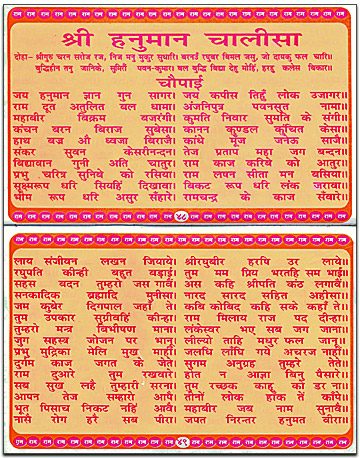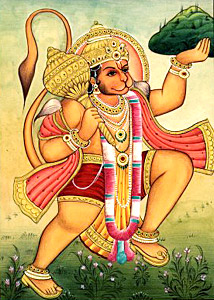 Hanuman Chalisa is a religious text. It literally means "Forty chaupais on Hanuman". It is a Hindi-language poem primarily praising Lord Hanuman and is Tulsidas`s most famous and read piece of literature apart from the Ramacharitamanasa. The conception of Hanuman Chalisa dates back to the 16th century.
Hanuman Chalisa is a religious text. It literally means "Forty chaupais on Hanuman". It is a Hindi-language poem primarily praising Lord Hanuman and is Tulsidas`s most famous and read piece of literature apart from the Ramacharitamanasa. The conception of Hanuman Chalisa dates back to the 16th century.
Hanuman Chalisa has gained enormous popularity among the modern-day Hindus. Many of them recite it as a prayer every week, commonly on Tuesdays or Saturdays. Shri Hanuman is a bachelor God and many bachelors are staunch devotees of this Rudra avatara. "Sri Guru Charana Saroj raja Nija Mana Mukura sudhaar Baranou raghubara bimala jasu jo daayaka phala chaar" is the first verse of Hanuman Chalisa that means "Touching the feet of my teacher, I cleanse my mind and go on to describe Hanuman and his success who is the giver of the four fruits". This verse chants the Hanuman Chalisa starts off with a prayer to Lord Hanuman and also mentions as to what he will be doing through the 40 verses.
"Budhee heena tanujaanike sumeero Pawana kumaar Balabudhee bidya dehu moheem harahu kalesha vikaar" is translated as "I, the person without enough knowledge (be it wordly knowledge or education or whatsoever), pray to the son of the Wind, give me the strength and the knowledge and take away all my miseries". Shri Hanuman is Pawana Putra as when he was born, the Wind God blessed him with immense powers. Hanuman was actually born when he drank the sacred potion for bearing children and the drink was carried by the Wind god and delivered to Shri Hanuman`s mother, Anjanee. Thus, he is also known as Pawan putra.
A prayer in Hanuman Chalisa says that "Jai Hanuman Gyana Gunasagara Jai Kapeesa Tihu loka ujaagara" that means Glory be to Hanuman who is the ocean of knowledge; Glory be to the monkey chief who lights of the 3 worlds. Another prayer says that "Rama doota atulita baladhaamaa Anjanee Putra pawanasuta naamaa", which renders the idea that Shri Hanuman was the messenger of Rama and a very strong man son of Anjanee and also called son of the Wind God.
 Shri Hanuman was considered as an avatara with exceptional valour and a body as strong as the thunderbolt; he was the dispeller of evil thoughts and a companion of good wisdom. These praising of Shri Hanuman is reflected in the statement of Hanuman Chalisa`s "Mahabir bikram bajarangee kumatee nivaara sumatee ke sangee". The entire poem of Hanuman Chalisa is about Shri Hanuman and his accomplishments. "Kanchana barana biraaja subesha kanana kundala kunchita kesha" says that with the golden coloured body and wearing good clothes with shiny earrings and beautiful curly hair it is own much honored Shri Hanuman. Haatha bajra aur dhwajaa birajay kaandhe moonj janeun saanje reflects the things; Shri Hanuman carries with himself, namely the flag and the thunderbolt. "Shankara suvana kesaree nandana teja pratapa maha jaga vandana" means that Shri Hanuman is the son of Shankara (shiva) and son of Kesari and the whole world salutes to Shri Hanuman.
Shri Hanuman was considered as an avatara with exceptional valour and a body as strong as the thunderbolt; he was the dispeller of evil thoughts and a companion of good wisdom. These praising of Shri Hanuman is reflected in the statement of Hanuman Chalisa`s "Mahabir bikram bajarangee kumatee nivaara sumatee ke sangee". The entire poem of Hanuman Chalisa is about Shri Hanuman and his accomplishments. "Kanchana barana biraaja subesha kanana kundala kunchita kesha" says that with the golden coloured body and wearing good clothes with shiny earrings and beautiful curly hair it is own much honored Shri Hanuman. Haatha bajra aur dhwajaa birajay kaandhe moonj janeun saanje reflects the things; Shri Hanuman carries with himself, namely the flag and the thunderbolt. "Shankara suvana kesaree nandana teja pratapa maha jaga vandana" means that Shri Hanuman is the son of Shankara (shiva) and son of Kesari and the whole world salutes to Shri Hanuman.
The poem of Hanuman Chalisa is strictly followed as a religious mantra and its verses are treated as vakyas to concentrate on Shri Hanuman and praise him. "Vidya vaana Gunee atee chatur Ramakaja kareebe ko aatur" means that Shri Hanuman is knowledgeable, with good character and very clever, always eager to perform duties for Rama. Shri Hanuman was an ardent follower of Lord Rama, Lakshama and Sita; this is expressed in the verse "Prabhu Charitra sunee be ko rasiya Rama Lashana Seeta Mana basiya". The entire life story of Shri Hanuman is expressed in Hanuman Chalisa, through its verses.
The verse "Raghupatee keenhee bahuta badhaayee tuma mama priya bharata sama bhayee" means that Raghupatee (Lord Rama) praised Lord Hanuman and said that he is as dear to him as his brother Bharata. The Hanuman Chalisa also states that Shri Hanuman has inspired many with his honest and devoted outlook and Vibheeshana one of them who followed his advice to become the king of Lanka. Shri Hanuman also visited Lanka and met Sita just to relieve her with the assurance that her husband Rama will be there very soon to save her; this is stated in the verse "Prabhu Mudrika meli mukha mayee jaladee laandhee gaye achara janahee".
Shri Hanuman is the receiver of the eight Siddhas, which were given by Mother Sita, namely, Anima: Reducing one`s body to the size of an atom Mahima and expanding one`s self to an infinitely large size; Laghima : Becoming infinitely light; Prapti : unrestricted access to all places; Garima : becoming infinitely heavy; Prakamya : Realizing whatever one desires; Istiva : absolute lordship and Vasitva : Subjugating all. This incident is stated in the phrase "Ashta Siddhee nava nidhee ke daataa Asabara deena jaankee maataa".
Hanuman Chalisa is one of the most revered, religious books of the Hindus. The Hanuman Chalisa is not only sacredly kept in the houses of Hanuman devotees but also in the houses of other Hindu worshippers.









